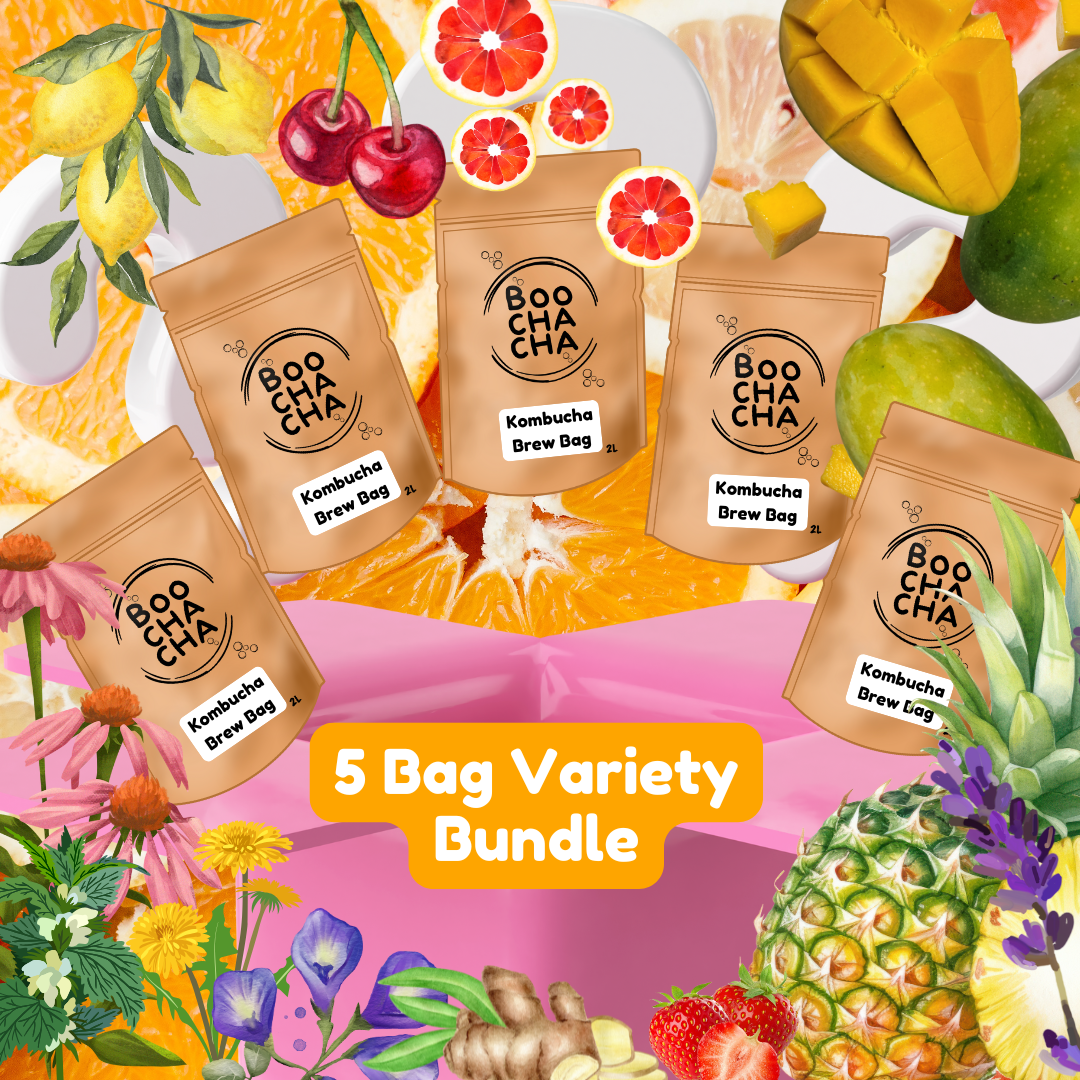Looking for a creative way to connect with your kids, explore the outdoors, and support gut health, all at the same time? Homemade Kombucha is more than just a trendy drink; it’s a hands-on, sensory-rich experience that’s perfect for families (just wait for your SCOBY to start to grow).
Our range of Kombucha Starter Kits are famous for being beginner friendly, for coming with our much-loved lifetime brewing support and for making delicious Kombucha right from your first brew.
Even better, you can turn it into a brewing adventure by gathering ingredients together from local fields, forests, or pick-your-own farms.

In this post, we’re sharing three kid-friendly Kombucha recipes using ingredients you can safely forage or harvest with your children. Each one celebrates natural flavour and introduces little ones to the magic of wild food - from fragrant elderflowers and minty streamside greens to juicy blackberries and citrusy pine.
If you need to add some fermentation safe bottles and sieves or funnels to your kitchen, check out our range of Kombucha brewing accessories here.

We use Kombucha brewed with Green Tea in all of these recipes, because that will give the Kombucha a lighter flavour (great for kids) and it will have lower amounts of caffeine (the caffeine is actually processed by the SCOBY during the fermentation, so tends to be only traces anyway, but this will depend from brew to brew, so best to limit it where possible).
More on brewing Kombucha with low or no caffeine here.
We’ll also walk you through how to identify each plant safely, what to look out for, and how to harvest responsibly, to make the whole process a meaningful (and delicious) nature lesson.
Elderflower & Wild Mint Kombucha
A lightly floral, naturally sweet and very fresh Kombucha, which will be light in colour, and probably look just like a fresh lemonade. If your kids love fizziness, top each serving with soda.
Elderflowers (Sambucus nigra)
When: Late May to early July
Where: Hedgerows, woodland edges, roadsides
What to Look For:
- Small creamy-white flowers in flat-topped clusters (called umbels)
- Each flower has 5 tiny petals
- The tree has feathery, serrated green leaves in opposite pairs and grows as a bush or small tree
What to Avoid:
- Don’t confuse with cow parsley or giant hogweed, which grow from the ground (not trees/shrubs) and ensure you only harvest flowers, not green stems or leaves
Foraging Tip: Smell the flowers—they should have a sweet, floral, musky scent. Shake gently to remove insects. Avoid flowers near roads.
We LOVE using Elderflower to flavour Kombucha, and this year we released a summer special Elderflower Kombucha Brew Bag, which can be used to brew the tea used to refill your fermentation vessel, if you missed the Elderflower foraging window this year, or haven't got time to go foraging.
Wild Mint (Mentha species)
When: Spring through autumn
Where: Damp areas—stream banks, wet meadows, shady garden corners
What to Look For:
- Square stems (a mint family trait)
- Bright green, oval-shaped leaves with toothed edges
- Bright green, oval-shaped leaves with toothed edges
- Strong minty aroma when crushed
- May have pale purple flowers in summer
What to Avoid:
- Don’t pick from polluted water edges
- Be cautious with pennyroyal, a toxic mint—distinguishable by its low-growing, rounder leaves and stronger smell
Foraging Tip: Encourage kids to compare the smell of wild mint with garden mint!

2. Strawberry & Lemon Balm Kombucha
A beautifully pink Kombucha that will taste so good, you wont believe its made from all natural ingredients. Swap the lemon balm for some fresh basil if that's tricky to find!
Make sure to buy organic Strawberries if buying from the shop.
Strawberries
When: June to July (wild); longer for cultivated
Where: PYO farms, forest clearings, sunny banks
What to Look For:
- 3-part leaves with toothed edges
- Tiny red berries (wild ones are smaller and more aromatic)
-
Small white flowers with yellow centres
What to Avoid:
- Don’t confuse with wood avens or cinquefoil, which have similar leaves but different flowers/berries
- Ensure berries are fully red and ripe before picking
Foraging Tip: Wild strawberries are a delight—smaller but sweeter. Kids can taste one to compare!
Lemon Balm (Melissa officinalis)
When: Late spring to autumn
Where: Gardens, hedges, woodland edges
What to Look For:
- Soft, bright green leaves with a wrinkled, quilted texture
- Lemon scent when crushed
- Square stems
- Tiny white/pale flowers in summer
What to Avoid:
- Don’t confuse with nettles (sting) or catnip—look for the lemony smell
Foraging Tip: Rub a leaf and ask kids to smell—should smell like lemon sherbet!

3. Blackberry & Pine Kombucha
A dark purple Kombucha with floral notes added for freshness from the pine needles. Blackberries must be everyone's favourite foraging goody, so this is a must try. Ribena's answer to Kombucha, coming right up.
Blackberries (Rubus fruticosus)
When: Late July to September
Where: Hedgerows, woodland edges, field margins
What to Look For:
- Thorny canes with palmate (hand-shaped) leaves
- Flowers: 5-petaled, pink or white
- Berries: green → red → deep purple-black when ripe
What to Avoid:
- Don't pick from polluted roadsides or low to the ground (dog wee zone)
- Overripe berries can be mushy or mouldy—choose firm and shiny
Foraging Tip: Bring a basket! Let kids taste-test and look for the deepest purple berries.
Pine Needles (Pinus species, like Scots Pine)
When: Year-round, best spring/summer for tender new growth
Where: Woodlands, parks
What to Look For:
- Needles in pairs (Scots pine), long and green
- Sticky, citrus-scented sap
- Young tips are lighter green and more tender
- Woody cones and reddish bark
What to Avoid:
- Yew trees (Taxus baccata) - highly toxic, especially seeds - Yew has flat, dark green, non-resinous needles, red berries, and no pine scent
- Also avoid cedars and cypresses for this recipe
Foraging Tip: Let kids sniff the needles—should smell sharp, citrusy, and piney.

Foraging Safety Tips (Especially for Kids):
Most important one: When in doubt, leave it out
- Always positively ID a plant with a guidebook, phone app or expert before using it
- Avoid areas with heavy traffic pollution or pesticides
- Pick respectfully - only what you need, never strip a plant
- Wash everything thoroughly before use
Infusing Your Kombucha
All of the recipes above involve brewing the Kombucha in what is called the first stage fermentation, and then adding this brewed Kombucha into a bottle with whatever flavours you have foraged.
Fresh ingredients are never added into the fermentation vessel with your SCOBY.
We have loads more fun Kombucha recipes on Our Kombucha Recipe Club, so if nothing here has tickled your fancy, head over there.
So, have a lovely summer break, with or without kids, foraging is fun, making Kombucha is easy, and there's not better time to join this wholesome brewing community.
If you make any of these, share them with us on our socials, we love to see you guys in action.


